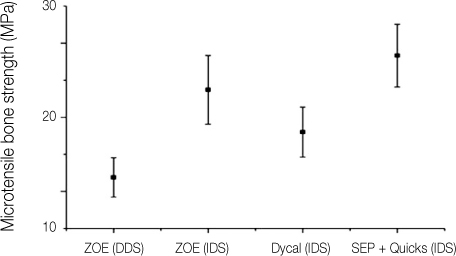J Korean Acad Conserv Dent.
2011 Sep;36(5):419-424. 10.5395/JKACD.2011.36.5.419.
Microtensile bond strength of resin inlay bonded to dentin treated with various temporary filling materials
- Affiliations
-
- 1Department of Conservative Dentistry, Chonnam National University School of Dentistry, Gwangju, Korea. wmoh@chonnam.ac.kr
- 2Depatment of Oral Anatomy, Chonnam National University School of Dentistry, Gwangju, Korea.
- KMID: 2176579
- DOI: http://doi.org/10.5395/JKACD.2011.36.5.419
Abstract
OBJECTIVES
This study was aimed to determine the effects of temporary sealing materials on microtensile bond strength between resin-coated dentin and resin inlay and to compare the bonding effectiveness of delayed dentin sealing and that of immediate dentin sealing.
MATERIALS AND METHODS
The teeth were divided into 4 groups: group 1, specimens were prepared using delayed dentin sealing after temporary sealing with zinc oxide eugenol (ZOE); group 2, specimens were prepared using immediate dentin sealing and ZOE sealing; group 3, specimens were prepared using immediate dentin sealing and Dycal (Dentsply) sealing; group 4, specimens were prepared using immediately sealed, and then temporarily sealed with a resin-based temporary sealing material. After removing the temporary sealing material, we applied resin adhesive and light-cured. Then the resin inlays were applied and bonded to the cavity with a resin-based cement. The microtensile bond strength of the sectioned specimens were measured with a micro-tensile tester (Bisco Inc.). Significance between the specimen groups were tested by means of one-way ANOVA and multiple Duncan's test.
RESULTS
Group 1 showed the lowest bond strength, and group 4 showed the highest bond strength (p < 0.01). When temporary sealing was performed with ZOE, immediate dentin sealing showed a higher bonding strength than delayed dentin sealing (p < 0.01).
CONCLUSIONS
Based on these results, immediate dentin sealing is more recommended than delayed dentin sealing in bonding a resin inlay to dentin. Also, resin-based temporary sealing materials have shown the best result.
MeSH Terms
Figure
Reference
-
1. Peters MC, McLean ME. Minimally invasive operative care. I. Minimal intervention and concepts for minimally invasive cavity preparations. J Adhes Dent. 2001. 3:7–16.2. Irie M, Suzuki K. Current luting cements: marginal gap formation of composite inlay and their mechanical properties. Dent Mater. 2001. 17:347–353.
Article3. Christensen GJ. Acceptability of alternatives for conservative restoration of posterior teeth. J Esthet Dent. 1995. 7:228–232.
Article4. Kim TG, Lee KW, Yu MK. The effect of temporary filling materials on the adhesion between dentin adhesive-coated surface and resin inlay. J Korean Acad Conserv Dent. 2008. 33:553–559.
Article5. Magne P. Immediate dentin sealing: a fundamental procedure for indirect bonded restorations. J Esthet Restor Dent. 2005. 17:144–154.
Article6. Magne P, Kim TH, Cascione D, Donovan TE. Immediate dentin sealing improves bond strength of indirect restorations. J Prosthet Dent. 2005. 94:511–519.
Article7. Cho NY, Lee IB. Polymerization shrinkage, hygroscopic expansion and microleakage of resin-based temporary filling materials. J Korean Acad Conserv Dent. 2008. 33:115–124.
Article8. Stavridakis MM, Krejci I, Magne P. Immediate dentin sealing of onlay preparations: thickness of pre-cured dentin bonding agent and effect of surface cleaning. Oper Dent. 2005. 30:747–757.9. Sultana S, Nikaido T, Matin K, Ogata M, Foxton RM, Tagami J. Effect of resin coating on dentin bonding of resin cement in Class II cavities. Dent Mater J. 2007. 26:506–513.
Article10. Udo T, Nikaido T, Ikeda M, Weerasinghe DS, Harada N, Foxton RM, Tagami J. Enhancement of adhesion between resin coating materials and resin cements. Dent Mater J. 2007. 26:519–525.
Article11. Okuda M, Nikaido T, Maruoka R, Foxton RM, Tagami J. Microtensile bond strengths to cavity floor dentin in indirect composite restorations using resin coating. J Esthet Restor Dent. 2007. 19:38–46.
Article12. Begazo CC, de Boer HD, Kleverlaan CJ, van Waas MA, Feilzer AJ. Shear bond strength of different types of luting cements to an aluminum oxide-reinforced glass ceramic core material. Dent Mater. 2004. 20:901–907.
Article13. Santos-Daroz CB, Oliveira MT, Góes MF, Nikaido T, Tagami J, Giannini M. Bond strength of a resin cement to dentin using the resin coating technique. Braz Oral Res. 2008. 22:198–204.
Article14. Kim DW, Park SJ, Choi KK. Compatibility of self-etching dentin adhesives with resin luting cements. J Korean Acad Conserv Dent. 2005. 30:493–504.
Article15. Magne P, So WS, Cascione D. Immediate dentin sealing supports delayed restoration placement. J Prosthet Dent. 2007. 98:166–174.
Article16. Suzuki S, Cox CF, White KC. Pulpal response after complete crown preparation, dentinal sealing, and provisional restoration. Quintessence Int. 1994. 25:477–485.
Article17. Paul SJ, Schärer P. Effect of provisional cements on the bond strength of various adhesive bonding systems on dentine. J Oral Rehabil. 1997. 24:8–14.
Article
- Full Text Links
- Actions
-
Cited
- CITED
-
- Close
- Share
- Similar articles
-
- The Effect of Temporary Filling Materials on The Adhesion between Dentin Adhesive-coated Surface and Resin Inlay
- The comparison of microtensile bond strength with immediate and delayed dentin sealing
- The effect of delayed composite resin filling on microtensile bond strength
- Bonding efficacy of cured or uncured dentin adhesives in indirect resin
- Bonding of a resin-modified glass ionomer cement to dentin using universal adhesives


